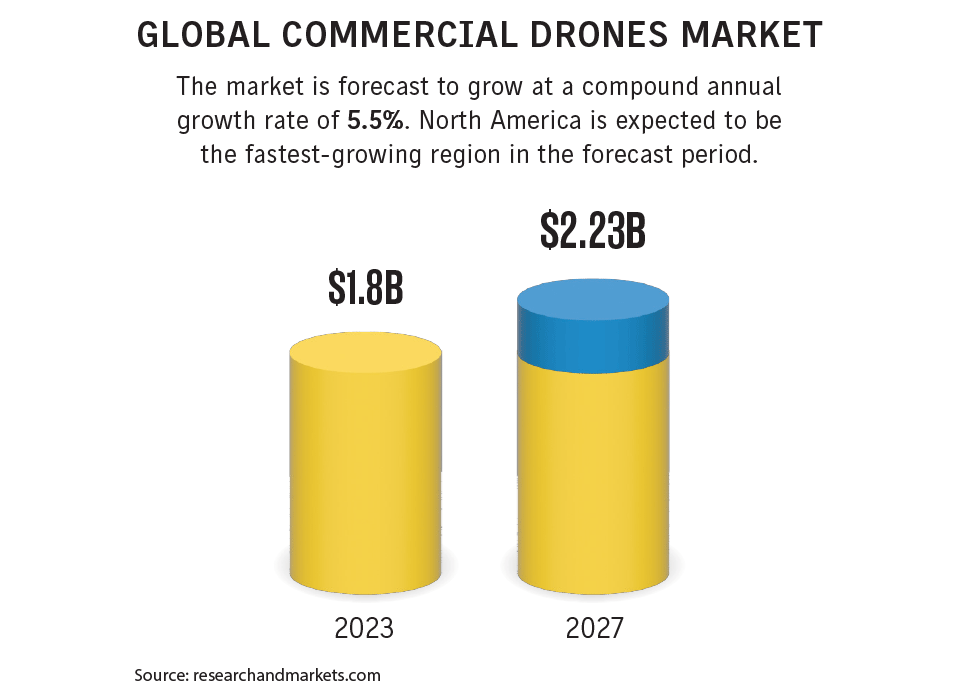Drones tapped to improve risk management
Reprints
Drones have been deployed by insurers and risk managers for several years to better assess risks, respond to catastrophes and improve claims efficiency.
But as other technological tools have become more widely available, businesses and insurers are using the unmanned aircraft systems in more targeted ways to collect data and to mitigate risk, experts say.
Agriculture, construction, real estate and specialty lines are just some of the insurance industry sectors where drones are improving risk management practices, they said.
More than 70 crop adjusters at Rural Community Insurance Services Inc., the crop insurance business of Zurich North America, are certified drone pilots, said Sam Arocho, procedural case manager at RCIS, who is based in Loxahatchee, Florida.
Instead of underwriters and adjusters walking through orchards to inspect crops of apples, peaches and pecans, drones provide aerial views of large tracts of land to determine whether a farming practice is a good underwriting risk and to provide risk control recommendations to policyholders, he said.
Drones also capture the size and severity of crop damage after a loss, he said. “An adjuster walking through 500 acres of corn can take a long time to figure out where the damage locations are, whereas drones can see essentially the whole field at once and spot different areas of damage,” Mr. Arocho said.
Zach Wright, risk management analyst II, at Jacksonville, Florida-based Haskell Co. Inc., an architecture, engineering, construction and consulting company, said the company has a fleet of about 25 drones that it uses for 3D modeling and mapping of construction sites.
The models can accurately determine if the ground is level at greenfield sites before construction begins and then track progress, Mr. Wright said. “The last thing you want is a building that is crooked,” he said.
Haskell also overlays its design plans on top of the models to compare them with actual construction at the site.
“We had a project where we were running conduit cable just outside of where we were building the foundations. We mapped it and put the design down and they were about three feet off,” he said. Catching the mistake early prevented what could have been a significant project delay, he said.
High-resolution aerial photos of undeveloped land can be captured by drones in otherwise inaccessible areas, which reduces human risk, said Penni L. Nelson, Dallas-based vice president of risk management at real estate developer Hillwood, a Perot company.
By gathering accurate data about land it might develop, drone technology enables Hillwood’s leaders to make better business decisions, Ms. Nelson said. Using drones also reduces the company’s carbon footprint, she said.
The National Transportation Safety Board uses drones as part of its investigations into air accidents. The accuracy of information gathered, such as how an aircraft impacted the ground, can inform the aircraft’s insurers, said Thomas Vargo, Morristown, New Jersey-based aerospace and specialty claims lead for the Americas at Axa XL, a unit of Axa SA.
If an aircraft needs to be recovered as part of a claims investigation, Axa XL hires a third-party retrieval company that might deploy drones to recover it and conduct cleanup at the site, he said. Survey mapping of a crash site also helps the insurer determine the easiest way to conduct a recovery, he said.
FM Global last year decided to put its drones in the hands of its risk engineers and to use them in a more targeted way, said Jaap de Vries, Providence, Rhode Island-based staff vice president, principal innovation specialist, at the mutual insurer. Previously, the insurer used third-party drone pilots.
The primary use of drones at the insurer is safe roof access, said Tyler Izzi, senior staff engineer at FM Global headquarters in Johnston, Rhode Island. “Drones have enabled that and allowed us to access roof areas that were previously inaccessible,” he said.
Interest in drone technology is growing internationally, and FM Global now has over 40 risk engineers in the process of getting their pilot licenses; it had about nine certified pilots across the U.S. this time last year, Mr. Izzi said.
Drones have high-definition cameras and can take photos one to two feet above a roof, compared with satellite images, said Jim Wucherpfennig, vice president of property claims at Travelers Cos. Inc. in Hartford, Connecticut.
“That’s the key with drones. You can really see even small damages, imperfections in a row of roof shingles, or a small hail hit,” Mr. Wucherpfennig said.
The industry is still in the early stages of evolution in its use of drones and other nontraditional claims-handling options, said Meredith Brogan, Atlanta-based president of WeGoLook, a Crawford & Co. company.
The improved quality of aerial view photos captured by drones is driving higher usage by desk adjusters, she said, noting the accuracy of measurements and damage-detection capabilities of these technologies has advanced.
